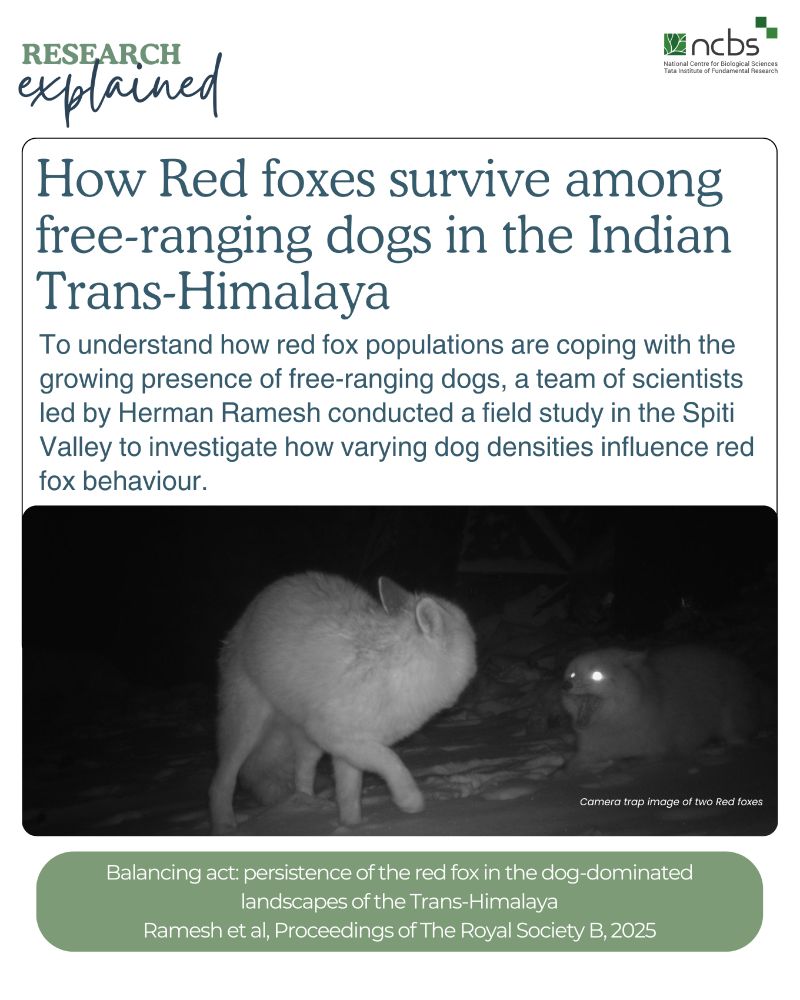Multimedia Science Communicator-Journalist, Illustrator, Media and Public Relations
My latest for @MongabayIndia on why elasmobranchs need local actions grounded in species biology.
india.mongabay.com/2025/09/indi...
My latest for @MongabayIndia on why elasmobranchs need local actions grounded in species biology.
india.mongabay.com/2025/09/indi...
A recent study from Prof. @rpadinjat.bsky.social and Prof R. Sowdhamini's lab found that genes encoding PIP4K—a key enzyme in the phosphoinositide signalling pathway that regulates PIP3 levels—are found exclusively in metazoans.
Read: bit.ly/3TIyxo0
✏️@rupsykhurana.bsky.social

A recent study from Prof. @rpadinjat.bsky.social and Prof R. Sowdhamini's lab found that genes encoding PIP4K—a key enzyme in the phosphoinositide signalling pathway that regulates PIP3 levels—are found exclusively in metazoans.
Read: bit.ly/3TIyxo0
✏️@rupsykhurana.bsky.social
🐕Free-ranging dogs are changing Spiti Valley's fragile food web, forcing red foxes to adapt.
🦊NCBS MSc. Wildlife program alumnus Herman Ramesh & team investigated how varying dog densities influence red fox behaviour.
Read here: bit.ly/3IukakD
✏️ @rupsykhurana.bsky.social

🐕Free-ranging dogs are changing Spiti Valley's fragile food web, forcing red foxes to adapt.
🦊NCBS MSc. Wildlife program alumnus Herman Ramesh & team investigated how varying dog densities influence red fox behaviour.
Read here: bit.ly/3IukakD
✏️ @rupsykhurana.bsky.social
Much of what we know about health and disease comes from studies in Western populations, which means the
diagnostic tools, biomarkers, and even treatments may not be optimal for people in India or other non-Western countries.
www.thehindu.com/sci-tech/hea...
DM for copy

Much of what we know about health and disease comes from studies in Western populations, which means the
diagnostic tools, biomarkers, and even treatments may not be optimal for people in India or other non-Western countries.
www.thehindu.com/sci-tech/hea...
DM for copy
In a first, @vivekharisundar.bsky.social & team from Dr @shivaprasadpv.bsky.social 's group has identified a new H4 histone variant in rice which may have helped semi-aquatic rice varieties adapt to changing environments.🌾
Read here: bit.ly/4jNcirp
By @rupsykhurana.bsky.social

In a first, @vivekharisundar.bsky.social & team from Dr @shivaprasadpv.bsky.social 's group has identified a new H4 histone variant in rice which may have helped semi-aquatic rice varieties adapt to changing environments.🌾
Read here: bit.ly/4jNcirp
By @rupsykhurana.bsky.social
I explore the world of animals that is beyond our imagination. Colors we cannot see, sounds we cannot hear and so much more.
What might seem absurd is just another way of being.
DM me for a copy or the story is freely available on HT app.
#animal #senses

I explore the world of animals that is beyond our imagination. Colors we cannot see, sounds we cannot hear and so much more.
What might seem absurd is just another way of being.
DM me for a copy or the story is freely available on HT app.
#animal #senses
Welcome to the campus, Dr @pritiagarwal.bsky.social !
🎙️In an interview with Rupsy Khurana, Dr Priti Agarwal talks about her journey, motivations, and research, along with her exciting plans for the future at NCBS.
Read Here: news.ncbs.res.in/spotlight/nc...
@rupsykhurana.bsky.social

Welcome to the campus, Dr @pritiagarwal.bsky.social !
🎙️In an interview with Rupsy Khurana, Dr Priti Agarwal talks about her journey, motivations, and research, along with her exciting plans for the future at NCBS.
Read Here: news.ncbs.res.in/spotlight/nc...
@rupsykhurana.bsky.social
Himanshu C. & team from Prof Uma Ramakrishnan's group is using trace DNA at livestock kill sites to help ID the exact predator- species & individual, paving the way for more informed & strategic conservation resolutions
Read here: bit.ly/4k1HKmL
✏️ @rupsykhurana.bsky.social

Himanshu C. & team from Prof Uma Ramakrishnan's group is using trace DNA at livestock kill sites to help ID the exact predator- species & individual, paving the way for more informed & strategic conservation resolutions
Read here: bit.ly/4k1HKmL
✏️ @rupsykhurana.bsky.social
My latest for @thehindu.com is on an evolutionary arms race in real time.
www.thehindu.com/sci-tech/sci...

My latest for @thehindu.com is on an evolutionary arms race in real time.
www.thehindu.com/sci-tech/sci...
My latest for @thehindu.com is on an evolutionary arms race in real time.
www.thehindu.com/sci-tech/sci...

My latest for @thehindu.com is on an evolutionary arms race in real time.
www.thehindu.com/sci-tech/sci...
Australia and Asia boast rich biodiversity that is also unique. A simple yet popular way to understand these ‘separate greatnesses’ has taken the shape of the Wallace line.
www.thehindu.com/sci-tech/sci...
Thank you for the edits, Vasudevan Mukunth.

Australia and Asia boast rich biodiversity that is also unique. A simple yet popular way to understand these ‘separate greatnesses’ has taken the shape of the Wallace line.
www.thehindu.com/sci-tech/sci...
Thank you for the edits, Vasudevan Mukunth.

Our latest comic with Tinkle Comics Studio featuring the inspiring story of Dr Dimple Notani is out now!
Dimple is an Associate Professor at NCBS studying gene regulation.
Check it out and let us know your thoughts in the comments below!
#sciencecomics
@dimplenotani.bsky.social


In my latest for @deccanherald
Read more at: www.deccanherald.com/health/catch...

In my latest for @deccanherald
Read more at: www.deccanherald.com/health/catch...
As people age, they accrue richer experiences and their wisdom deepens.
So do animals. Without these elders, fish may never find their spawning grounds and birds would get waylaid as they flew across continents.
DM for a copy.
www.thehindu.com/sci-tech/ene...

As people age, they accrue richer experiences and their wisdom deepens.
So do animals. Without these elders, fish may never find their spawning grounds and birds would get waylaid as they flew across continents.
DM for a copy.
www.thehindu.com/sci-tech/ene...
As people age, they accrue richer experiences and their wisdom deepens.
So do animals. Without these elders, fish may never find their spawning grounds and birds would get waylaid as they flew across continents.
DM for a copy.
www.thehindu.com/sci-tech/ene...

As people age, they accrue richer experiences and their wisdom deepens.
So do animals. Without these elders, fish may never find their spawning grounds and birds would get waylaid as they flew across continents.
DM for a copy.
www.thehindu.com/sci-tech/ene...
thehindu.com/sci-tech/scien…#beese#emergingdiseasese#diseaseses
thehindu.com/sci-tech/scien…#beese#emergingdiseasese#diseaseses

